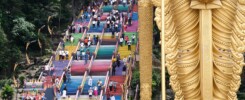Saigon. 35ºC. 90% humidity. Early evening in late April, but already dark. The thick warm air reminds me of a summer rain put into a sauna (and a little bit of arriving in Rio de Janeiro half a year ago). This time, we don’t need to find our Uber driver at the bustling airport, we are welcomed and picked up by the HCMC conservatory with whom I am collaborating.
Motor scooters are the number one means of transportation in Vietnam, for vendors, for couples, for families, for people with or without luggage. Thankfully, we are comfortably seated in a spacious taxi. Traffic is flowing like a roaring stream that never stops. There are no lanes and no rules, except one: never stop. If you want to cross the street as a pedestrian, you just walk in a steady pace no matter how busy the street is. Scooters and cars will find their way around you, you just have to trust and walk. Sidewalks are not made for walking, they are places for cooking, eating, socialising, parking, burning stuff in memory of the ancestors, etc. As a pedestrian, life isn’t easy at all and sometimes we’re feeling exhausted just from walking down the street to the next Pho kitchen.
Bui Vien. Food and party street. Squatting rather than sitting on tiny plastic chairs along the street, we enjoy cold Saigon beer and a fresh coconut along with peanuts and quail eggs sold by an old lady in a plastic bag together with salt carefully packed in a slip of newspaper. Watching the busy street with shiny neon lights, female street vendors selling plastic toys, and motor scooters equipped with loudspeakers and entire kitchens ready to prepare you a fresh dish of dried octopus, eggs, and rice, we are in no need of any other entertainment.
The next day I get picked up by the conservatory’s driver to go to my first rehearsal with Mrs. Nhi, harp teacher, wife of the conservatory’s director, and mother of clarinet teacher Quan Hoang. We are rehearsing “The Swan” from Saint-Saens’ “The Carnival of the Animals ” to perform it at the harp concert titled “Wings of Angels”. Later that day I’m giving a masterclass for the clarinet students, showing them breathing exercises and warm-ups, concluding with a short introduction to extended playing techniques. At “Wings of Angels” it’s the first time I feel slightly underdressed with my cotton jumpsuit compared to all the shiny dresses. To conclude a fabulous concert, we musicians are honoured with big flower bouquets and countless photos with each and everyone. My personal highlight, however, was the dinner afterwards with all performers together digging into the excellent cuisine of Saigon.
Da Lat. 27ºC. Green mountains. Famous for Arabica coffee, strawberries, avocados, and flowers. Most wind & brass players come from this area because of their greater lung capacities. The UNESCO Creative Music City is located in the central highlands a six-hour drive from Saigon. With Reunification Day and International Workers’ Day holidays ahead, all busses were already fully booked, but Sebastian managed to book us a private driver for the whole journey. In no other country we visited so far could we have found someone driving us all day long to a distant city up in the mountains for a similar price as three bus tickets.
The HCMC conservatory connected me with local art venue Phố Bên Đồi to give a workshop as well as a concert. I was very eager and also curious to come here because of the chance to get to know Vietnamese traditional music and play together with Mrs. Quyến, an experienced Dan Tranh player. We meet for the first time on the day before the concert and our collaboration turns out quite different to the ones I had before. Mrs. Quyến teaches me two Vietnamese folk songs, so I can play along with her. Ms. Khánh from Phố Bên Đồi is translating our entire conversation. In the end I’m allowed to not only play the taught melodies but also vary and improvise with them as long as it fits harmonically.
The workshop the next day is quite special too as my audience are not composers or clarinettists, but people generally interested in music and art. The kind of questions I get asked are very interesting for me, like “This instrument is so big, and you can play very loud and forcefully, but you’re a woman, how is that comparable?” Also, the feedback has been truly lovely “Thank you for all your sounds. I could hear a forest and all its animals.” Later at the concert I recognise many workshop participants and I am overwhelmed by the sheer number of people coming. Any chair available is brought to the hall and everyone else is sitting on the floor. Nearly 200 people are listening to my solo set and our duo building bridges between contemporary bass clarinet and traditional Vietnamese Dan Tranh.









































